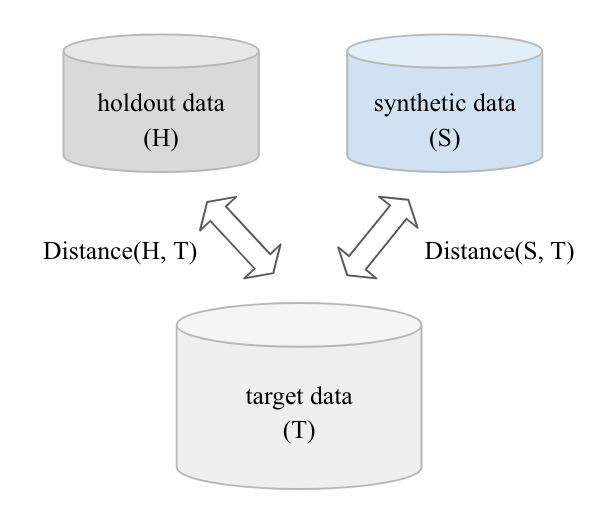The Virtual Data Lab is a python-based framework to assess generative models for sequential data with respect to their accuracy as well as privacy given a range of real-world and machine-generated datasets. In addition, it contains basic synthesizers capable of sequential data generation. The DL-based generative models, developed by MOSTLY AI as part of their commercial offering, are not part of this package.
- License: GPLv3
- Development Status: Alpha
It is comparable to the SDGym by MIT, but differs in terms of its sole focus on sequential data, and its inclusion of privacy metrics.
It is recommended to install virtualdatalab in a Conda virtual environment to avoid interfering with other software programs.
# create conda env named `vdl`
conda create --name vdl
conda activate vdl
conda install pip
cd virtualdatalab
pip install -r requirements.txt
pip install . Synthesizers and public functions accept only data formatted according to the following guideline. The generated data will adhere to that same format.
common data format:
- data resides within a single pandas DataFrame
- DataFrame indexes:
id- identifying a subject/person/indivudalsequence_pos- order of sequences belonging to one subject
- DataFrame columns are either of type
numericorcategorical - No NaN values. NaN values in categorical columns will be treated as the empty string
The helper method target_data_manipulation.prepare_common_data_format can read in CSV files, and provides data in the required format.
-
Data Processing
- Convert to Common Data Format
target_data_manipulation.prepare_common_data_format- loads in a data source and prepares it to fit common data format
- currently accepts
strfilepath to CSV or a Pandas DataFrame - data is assumed to be ordered within subject
- Convert to Common Data Format
-
Mock Data Generation && Datasets
- Mock Data Generator
target_data_generate.generate_simple_seq_dummy- numeric columns [0,1] uniform
- categorical alphabet uniformly drawn
- Selected real-word datasets
- CDNOW - Online purchase for CDs
virtualdatalab.datasets.loader.load_cdnow()- 19'625 users with a sequence of 5 purchases
- source: http://www.brucehardie.com/datasets/
- BERKA - Retail bank transactions
virtualdatalab.datasets.loader.load_berka()- 44'000 users with a sequence of 10 transactions
- source: https://data.world/lpetrocelli/czech-financial-dataset-real-anonymized-transactions
- MLB - Batting statistics for MLB players
virtualdatalab.datasets.loader.load_mlb()- 4'000 baseball players with 8 recorded seasons
- source: http://www.seanlahman.com/baseball-archive/statistics/
- (c) 1996-2020 by Sean Lahman - http://creativecommons.org/licenses/by-sa/3.0/
- RETAIL - Grocery retail orders and product items
virtualdatalab.datasets.loader.load_retail()- 10'000 users with a sequence of 100 ordered products
- CDNOW - Online purchase for CDs
- Mock Data Generator
-
Included Synthesizers
- IdentitySynthesizer
- Returns a sample of the original data
- ShuffleSynthesizer
- Returns a sample of the column-wise shuffled original data
- FlatAutoEncoder
- Encoder - Decoder Fully Connected NN in PyTorch
- IdentitySynthesizer
-
Metrics
metrics.compare- given a target dataset and synthetic dataset, compute accuracy and privacy themed metrics (See Metric Definitions)
-
Experimental Set-up
benchmark.benchmark- compute
metrics.comparewith many synthesizers across many datasets - if no datasets are passed then the default datasets are used (CDNOW + Berka)
- compute
benchmark takes a simple combination of the metrics below to output one indicator per type.
These metrics quantify the difference between the empirical distributions of the target compared to the synthetic data. Numeric variables are being discretized by binning these into 10 equally-spaced buckets. Categorical variables are considering the top 10 values, and lump together all remaining values into a single bucket.
First, for each subject a single event is randomly selected. Then, for each column, resp each combination of 2, 3 or 4 columns the distance between empirical distribution is being calculated, and then averaged across a random subset of max. 100 of such combinations:
- Total Variation Distance (TVD) = maximum deviation in relative frequency
- L1-Distance (L1D) of empirical distributions = sum over all deviations in relative frequency
In addition, we calculate two coherence measures for each attribute over the sequence, and .
- L1-Distance for share of subjects per category
- L1-Distance for share of distinct categories per subject
These metrics quantify the distance between individual synthetic data records to their closest target records. These distances are then related to the same distance measures applied to actual holdout data.
-
Distance to Closest Records (DCR): Calculates the distance of each synthetic record to a record in the target distribution. These distances must not be systematically smaller than the distances between holdout and target.
-
Nearest Neighbour Distance Ratio (NNDR): Ratio of the distance of each synthetic record to its closest to the second closest record in the target distribution. Again, these ratios should not be systematically smaller than the ratios derived for the holdout set.
Collection of notebooks with examples.
- identity_synthesizer_dummy.ipynb
- IdentitySynthesizer demo with Dummy Data
- flatautoencoder_cdnow.ipynb
- FlatAutoEncoder demo with CDNOW - accuracy
- benchmark_example.ipynb
- Benchmark default settings: CDNOW + BERKA + MLB, IdentitySynthesizer + ShuffleSynthesizer + FlatAutoEncoder
These notebooks can be run locally, as well as on Google Colab.
Prerequisites for the later is a Google account, if you intend to save to Google Drive. Saving to Github is not possible if the notebook are loaded from the MOSTLY AI public GitHub repo.
Note, that every launched notebook will need to reinstall VDL each time. Add the following code snippet to your Google Colab notebooks to do so.
"""
If running on Google Colab
"""
%mkdir vdl
%cd vdl
! git clone https://github.com/mostly-ai/virtualdatalab.git
%cd virtualdatalab/virtualdatalab
!pip install -r requirements.txt
!pip install .References:
Using Google Colab with Github
All synthesizers must extend synthesizes/base.py. Additionally, train and generate must invoke
parent method via super(). Parent functions ensure that common data format is respected and that models can not be
expected to generate if they have not been trained yet.
All synthesizer classes MUST accept the common data format. As a result, synthesizers are responsible for transformation of input data.
base.generate calls check_is_fitted. This check looks for attributes with _ naming convention. All synthesizers must
declare training attributes with this style.
class MyGenerator(BaseSynthesizer):
def train(self,data):
super().train(data)
data_model = some_transformation(data)
self.train_data_ = data
# model is now trained
self.data_model_ = data_model
def generate(self,number_of_subjects):
super().generate(self)
generated_data = some_generation(number_of_subjects)
return generated_data

